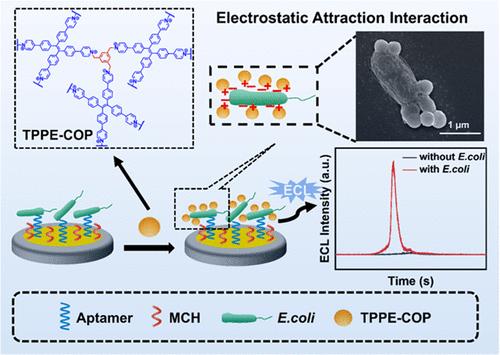用于高灵敏度细菌生物传感器的具有聚集诱导电化学发光特性的四苯基乙烯基共价有机聚合物
IF 6.7
1区 化学
Q1 CHEMISTRY, ANALYTICAL
引用次数: 0
摘要
四苯基乙烯(TPE)通常用作聚集诱导发射和聚集诱导电化学发光荧光团,已被广泛应用于制造荧光纳米材料和生物传感器。然而,制备具有强荧光(FL)和电化学发光(ECL)的良好TPE聚集体仍然是一个巨大的挑战。在本研究中,我们构建了一种具有高灵敏度的细菌 ECL 生物传感平台,该平台基于 TPE 共价有机聚合物(COP)纳米粒子,采用简单的 Menschutkin 反应策略合成,分别以携带溴基的分子和 1,1,2,2-四(4-(吡啶-4-基)苯基)乙烯作为交联剂和发射分子。ECL 大肠杆菌生物传感器具有高灵敏度、低检测限(0.19 CFU mL-1)、宽线性范围(1 × 102-5 × 106 CFU mL-1)和良好的选择性。细菌生物传感器的优异性能归功于均匀的球形 COP 纳米粒子,它具有增强的 FL 和 ECL 信号,其最大 ECL 效率是典型的三(联吡啶)钌(II)发射体的 8.4 倍。TPE 基 COP 纳米粒子的 FL 和 ECL 强度可通过改变携带溴基的分子来调节,从而调节其最高占有分子轨道(HOMO)和最低未占有分子轨道(LUMO)之间的能隙。基于 TPE 的 COP 纳米粒子具有很强的 FL 和 ECL 强度,为构建高灵敏度的细菌 ECL 生物传感器铺平了道路,可用于大规模筛查致病细菌。本文章由计算机程序翻译,如有差异,请以英文原文为准。

Tetraphenylethene-Based Covalent Organic Polymers with Aggregation-Induced Electrochemiluminescence for Highly Sensitive Bacterial Biosensors
Tetraphenylethene (TPE), which usually serves as aggregation-induced emission and aggregation-induced electrochemiluminescence fluorophores, has been widely applied in fabricating fluorescent nanomaterials and biosensors. However, it is still a tremendous challenge to prepare well-controlled TPE aggregates with strong fluorescence (FL) and electrochemiluminescence (ECL). In this study, we constructed a bacterial ECL biosensing platform with high sensitivity based on TPE-based covalent organic polymer (COP) nanoparticles synthesized by a simple Menschutkin reaction strategy to employ bromide group-carrying molecules and 1,1,2,2-tetrakis(4-(pyridine-4-yl)phenyl)ethene as the cross-linking agent and the emissive moiety, respectively. The ECL Escherichia coli biosensor had high sensitivity, a low limit of detection (0.19 CFU mL–1), a wide linear range (1 × 102–5 × 106 CFU mL–1), and good selectivity. The excellent properties of the bacterial biosensor could be attributed to the uniform spherical COP nanoparticles with enhanced FL and ECL signals, the maximal ECL efficiency of which was 8.4-fold higher than that of the typical tris(bipyridine) ruthenium(II) emitter. The FL and ECL intensities of the TPE-based COP nanoparticles could be adjusted by varying bromide group-carrying molecules and thus regulating their energy gap between highest occupied molecular orbital (HOMO) and lowest unoccupied molecular orbital (LUMO) orbitals. The TPE-based COP nanoparticles with strong FL and ECL intensities pave a promising avenue to construct highly sensitive bacterial ECL biosensors for the large-scale screening of disease-causing bacteria.
求助全文
通过发布文献求助,成功后即可免费获取论文全文。
去求助
来源期刊

Analytical Chemistry
化学-分析化学
CiteScore
12.10
自引率
12.20%
发文量
1949
审稿时长
1.4 months
期刊介绍:
Analytical Chemistry, a peer-reviewed research journal, focuses on disseminating new and original knowledge across all branches of analytical chemistry. Fundamental articles may explore general principles of chemical measurement science and need not directly address existing or potential analytical methodology. They can be entirely theoretical or report experimental results. Contributions may cover various phases of analytical operations, including sampling, bioanalysis, electrochemistry, mass spectrometry, microscale and nanoscale systems, environmental analysis, separations, spectroscopy, chemical reactions and selectivity, instrumentation, imaging, surface analysis, and data processing. Papers discussing known analytical methods should present a significant, original application of the method, a notable improvement, or results on an important analyte.
 求助内容:
求助内容: 应助结果提醒方式:
应助结果提醒方式:


